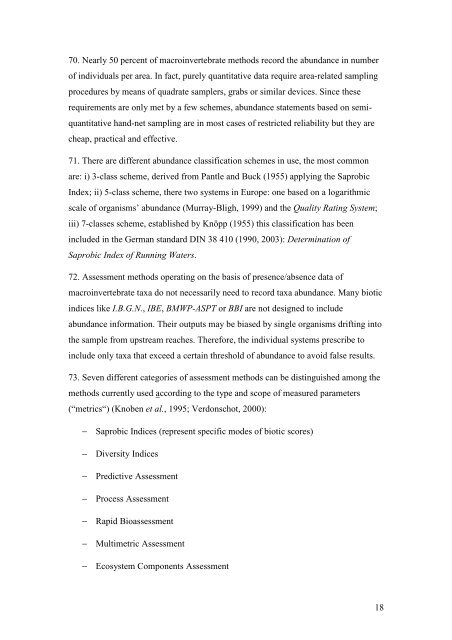Report on Harmonisation of freshwater biological methods
Report on Harmonisation of freshwater biological methods
Report on Harmonisation of freshwater biological methods
Create successful ePaper yourself
Turn your PDF publications into a flip-book with our unique Google optimized e-Paper software.
70. Nearly 50 percent <strong>of</strong> macroinvertebrate <strong>methods</strong> record the abundance in number<strong>of</strong> individuals per area. In fact, purely quantitative data require area-related samplingprocedures by means <strong>of</strong> quadrate samplers, grabs or similar devices. Since theserequirements are <strong>on</strong>ly met by a few schemes, abundance statements based <strong>on</strong> semiquantitativehand-net sampling are in most cases <strong>of</strong> restricted reliability but they arecheap, practical and effective.71. There are different abundance classificati<strong>on</strong> schemes in use, the most comm<strong>on</strong>are: i) 3-class scheme, derived from Pantle and Buck (1955) applying the SaprobicIndex; ii) 5-class scheme, there two systems in Europe: <strong>on</strong>e based <strong>on</strong> a logarithmicscale <strong>of</strong> organisms’ abundance (Murray-Bligh, 1999) and the Quality Rating System;iii) 7-classes scheme, established by Knöpp (1955) this classificati<strong>on</strong> has beenincluded in the German standard DIN 38 410 (1990, 2003): Determinati<strong>on</strong> <strong>of</strong>Saprobic Index <strong>of</strong> Running Waters.72. Assessment <strong>methods</strong> operating <strong>on</strong> the basis <strong>of</strong> presence/absence data <strong>of</strong>macroinvertebrate taxa do not necessarily need to record taxa abundance. Many bioticindices like I.B.G.N., IBE, BMWP-ASPT or BBI are not designed to includeabundance informati<strong>on</strong>. Their outputs may be biased by single organisms drifting intothe sample from upstream reaches. Therefore, the individual systems prescribe toinclude <strong>on</strong>ly taxa that exceed a certain threshold <strong>of</strong> abundance to avoid false results.73. Seven different categories <strong>of</strong> assessment <strong>methods</strong> can be distinguished am<strong>on</strong>g the<strong>methods</strong> currently used according to the type and scope <strong>of</strong> measured parameters(“metrics“) (Knoben et al., 1995; Verd<strong>on</strong>schot, 2000):− Saprobic Indices (represent specific modes <strong>of</strong> biotic scores)− Diversity Indices− Predictive Assessment− Process Assessment− Rapid Bioassessment− Multimetric Assessment− Ecosystem Comp<strong>on</strong>ents Assessment18














![Accommodation booking form [PDF]](https://img.yumpu.com/39471785/1/184x260/accommodation-booking-form-pdf.jpg?quality=85)

